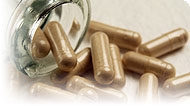Fit and Fast Recipes
Vitamin E for Sports & Fitness

How Much Is Usually Taken by Athletes?
Most controlled studies show that vitamin E does not benefit exercise performance,1 except possibly at high altitudes. A controlled study of mountain climbers at high altitude found that 400 IU per day of vitamin E improved anaerobic threshold, a physiological measure of aerobic endurance.2 More research is needed to determine whether this improvement might affect actual performance of athletic activities at high altitudes.
Strenuous exercise increases production of harmful substances called free radicals, which can damage muscle tissue and result in inflammation and muscle soreness. Antioxidants such as vitamin E might reduce this damage by neutralizing free radicals before they can damage the body.3, 4 While some research has reported that vitamin E supplementation in the amount of 800 to 1200 IU per day reduces biochemical measures of free radical activity and muscle damage caused by strenuous exercise,5, 6, 7 several studies have not found such benefit,8, 9, 10, 11 and no research has investigated the effect of vitamin E on performance-related measures of strenuous exercise recovery.
Side Effects
Vitamin E toxicity is very rare and supplements are widely considered to be safe. The National Academy of Sciences has established the daily tolerable upper intake level for adults to be 1,000 mg of vitamin E, which is equivalent to 1,500 IU of natural vitamin E or 1,100 IU of synthetic vitamin E.12
In a double-blind study of healthy elderly people, supplementation with 200 IU of vitamin E per day for 15 months had no effect in the incidence of respiratory infections, but increased the severity of those infections that did occur.13 For elderly individuals, the risks and benefits of taking this vitamin should be assessed with the help of a doctor or nutritionist.
In contrast to trials suggesting vitamin E improves glucose tolerance in people with diabetes, one trial reported that 600 IU per day of vitamin E led to impairment in glucose tolerance in obese people with diabetes.14 The reason for the discrepancy between reports is not known.
In a double-blind study of people with established heart disease or diabetes, participants who took 400 IU of vitamin E per day for an average of 4.5 years developed heart failure significantly more often than did those taking a placebo.15 Hospitalizations for heart failure occurred in 5.8% of those in the vitamin E group, compared with 4.2% of those in the placebo group, a 38.1% increase. Considering that some other studies have shown a beneficial effect of vitamin E against heart disease, the results of this study are difficult to interpret. Nevertheless, individuals with heart disease or diabetes should consult their doctor before taking vitamin E.
A review of 19 clinical trials of vitamin E supplementation concluded that long-term use of large amounts of vitamin E (400 IU per day or more) was associated with a small (4%) but statistically significant increase in risk of death.16 Long-term use of less than 400 IU per day was associated with a small and statistically nonsignificant reduction in death rates. This research has been criticized because many of the studies on which it was based used a combination of nutritional supplements, not just vitamin E. For example, the adverse effects reported in some of the studies may have been due to the use of large amounts of zinc or synthetic beta-carotene, and may have had nothing to do with vitamin E. It is also possible that long-term use of large amounts of pure alpha-tocopherol may lead to a deficiency of gamma-tocopherol, with potential negative consequences. For that reason, some doctors recommend that people who need to take large amounts of vitamin E take at least part of it in the form of mixed tocopherols.
Interactions with Supplements, Foods, & Other Compounds
Patients on kidney dialysis who are given injections of iron frequently experience “oxidative stress.” This is because iron is a pro-oxidant, meaning that it interacts with oxygen molecules in ways that may damage tissues. These adverse effects of iron therapy may be counteracted by supplementation with vitamin E.17
A diet high in unsaturated fat increases vitamin E requirements.
Interactions with Medicines
Certain medicines interact with this supplement.
none | |
Copyright © 2025 TraceGains, Inc. All rights reserved.
Learn more about TraceGains, the company.
The information presented by TraceGains is for informational purposes only. It is based on scientific studies (human, animal, or in vitro), clinical experience, or traditional usage as cited in each article. The results reported may not necessarily occur in all individuals. Self-treatment is not recommended for life-threatening conditions that require medical treatment under a doctor's care. For many of the conditions discussed, treatment with prescription or over the counter medication is also available. Consult your doctor, practitioner, and/or pharmacist for any health problem and before using any supplements or before making any changes in prescribed medications. Information expires December 2025.










